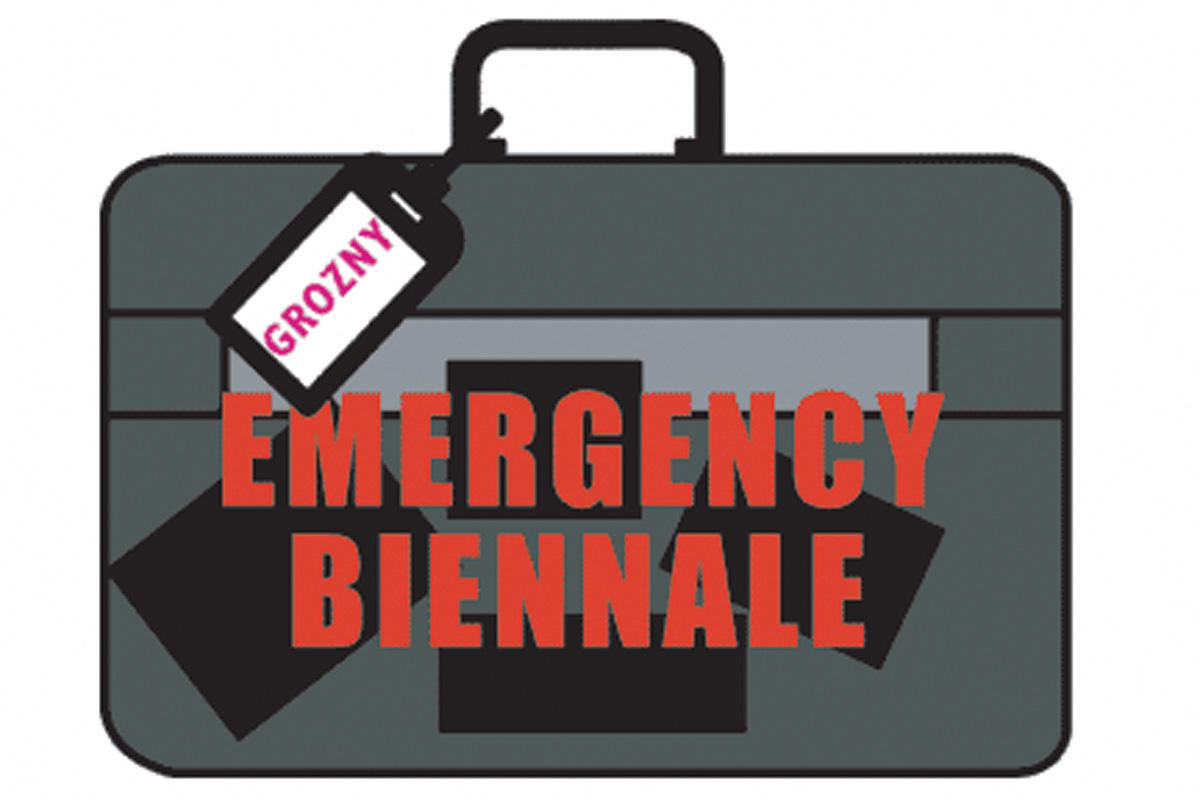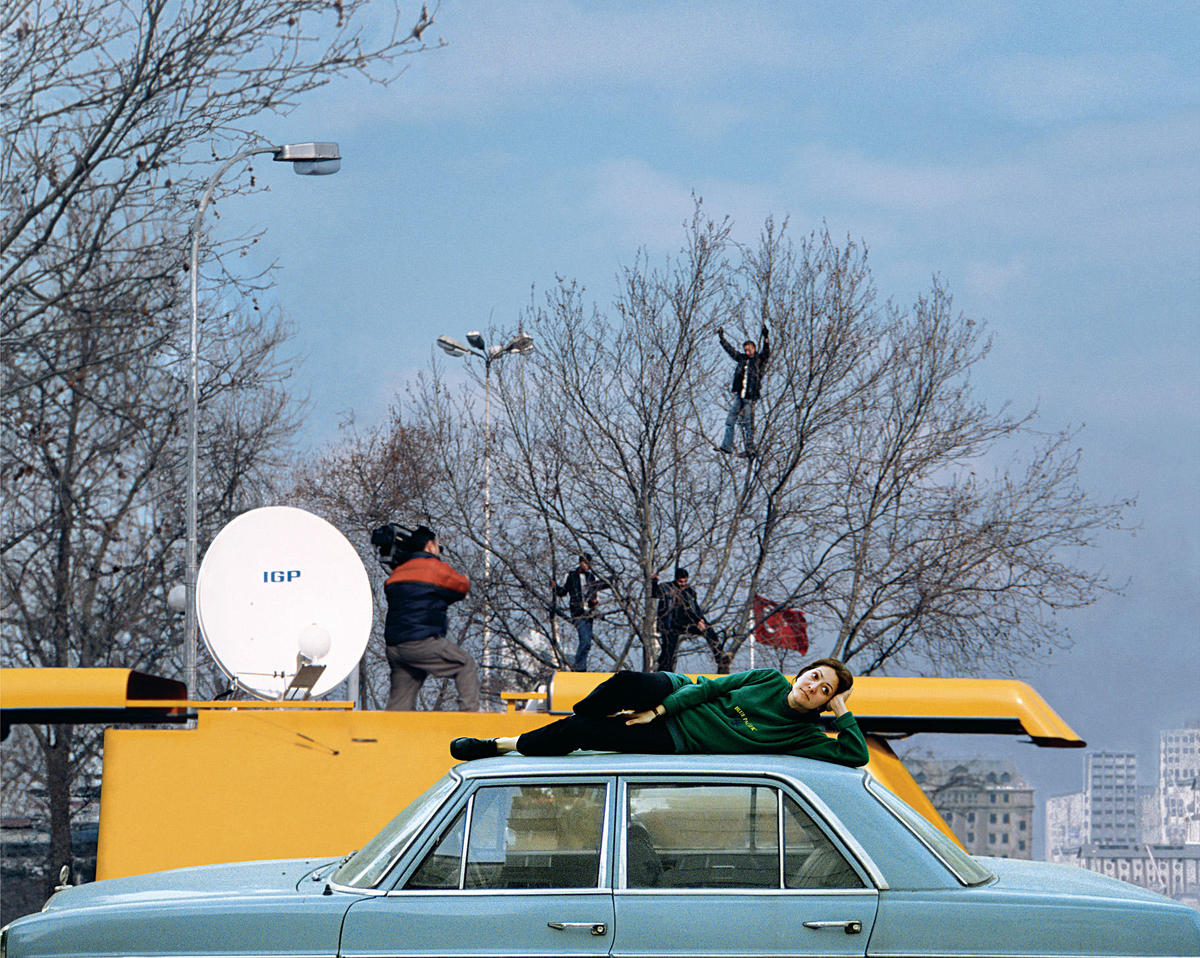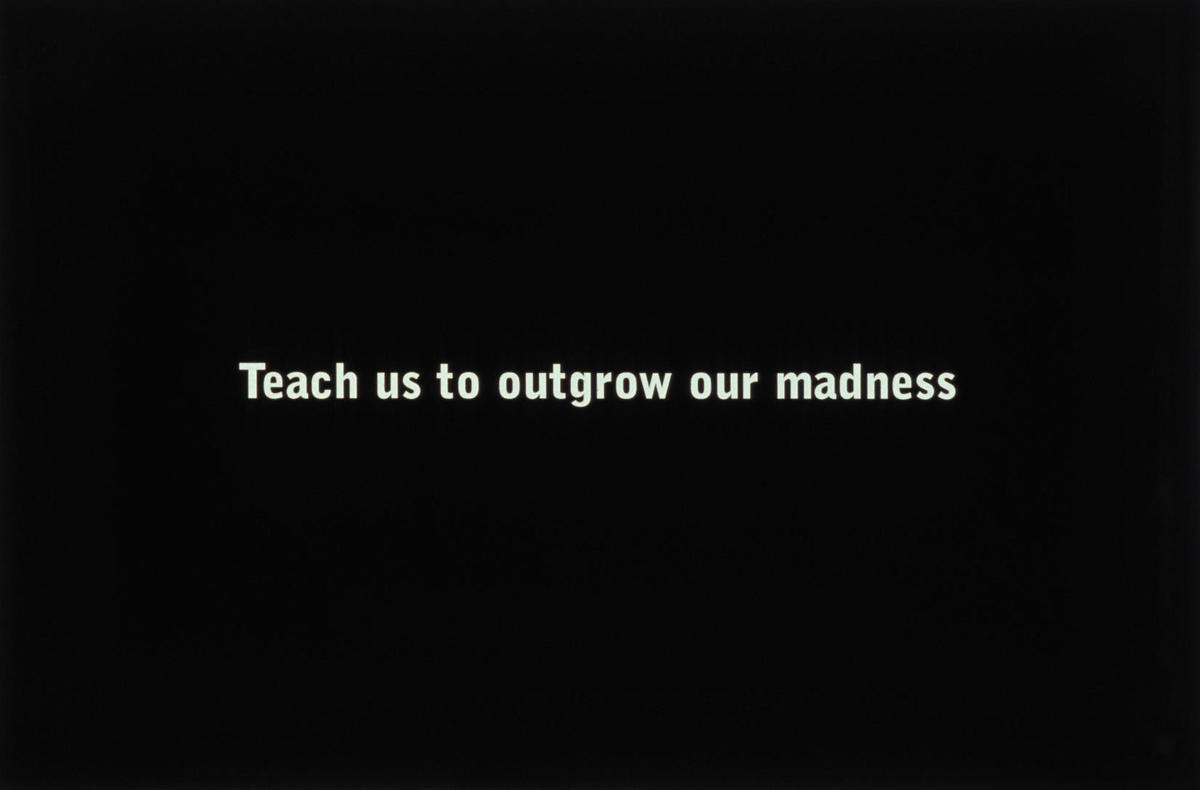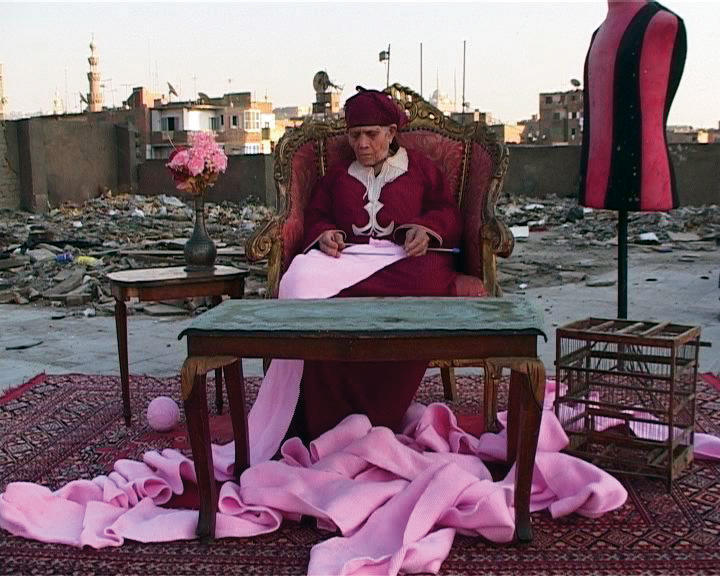
Paris
Grozny Emergency Biennale
Palais de Tokyo — Centre for Contemporary Creation
February 23–April 3, 2005
A suitcase filled with works, projects, and concepts by more than sixty artists from around the world recently hit the road, heading to a seldom visited and often forgotten destination: Chechnya. Simultaneously, a discreet corner of the vast Palais de Tokyo, Paris’s Centre for Contemporary Creation, duplicates and showcases what the artists were asked to provide for the traveling exhibit. Gathered under the title The Grozny Emergency, this self-proclaimed non-biennale is a call to artists’ solidarity, empathy, disgust, and frustration with the gritty reality of the ongoing conflict in Chechnya.
Plainly displayed facts state the sociopolitical manifesto-cum-background canvas for this anti-biennale. Among a powerful list of attestations, the spectrum hits hard, from the 100,000 deaths since 1999 and another 100,000 between 1994 and 1996, to the fact that only six of the hundred libraries in Grozny remain open today.
As part of Jota Castro’s one-man show Exposition Universelle 1, he and co-curator Evelyne Jouanno mobilized artists during the last week of January 2005, in anticipation of the anniversary on February 23rd of the first deportation of the Chechens in 1944; they set this as the symbolic date for sending off the trunk full of artworks. His was a call to engage, react, mobilize.
A solid outreach and informational program accompanies the temporary installation, including Mylene Sauloy and Manon Loizeau’s films on the daily life and culture of Chechens since the beginning of the first war in 1994; an Internet post with webcam and direct access to the website created for the occasion; as well as roundtable discussions organized by the International Federation of Human Rights Leagues (FIDH) on the current Chechnyan situation.
Organized with no funding and practically no time, the show presents raw responses, without flash. The setting is more rummage sale than white cube, forcing the viewer to practically unearth works envisaged for the long haul to Grozny. Artworks sensitively range from the handmade, rough-and-ready to more delicate finished objets including sketches, handkerchiefs, typewritten memos, pillows, leaflets, a trunk with a paper missile, clothing on hangers. Most of the artists’ works remain fittingly anonymous despite the long list of internationally renowned artists including Turkish art collective Oda Projesi, Francis Alys, Lucy Orta, Torino-based collaborative A Constructed World, Ghazel, Anton Vidokle, and many others.
The emergency of this biennale is about bringing attention to a socially engaged outlook, one that fittingly provokes two questions: What would one want to send? What would one want to receive on the other end? But most importantly, it highlights the raw social, political, and cultural Chechnyan reality, and more broadly, reminds us of conflicts elsewhere — stories that we should perhaps not fail to neglect whilst visiting the more glamorous biennales.

Istanbul
Normalization
Platform Garanti Contemporary Art Center
March 10–April 23, 2005
The mere mention of normalization carries with it a multitude of connotations. Post-war détente? Assimilationist rubric? From the macro level to the personal, it is this ambiguity that will likely spawn a diverse series of expressions in an exhibition program by that very title at Istanbul’s Platform Garanti this spring.
Acknowledging the contested nature of the normalization rubric, its historical roots as well as its present day nuances, lends a strong framework for organizers Vasif Kortun and November Paynter to initiate a dialogue with artists drawn from Turkey and further afield. Featured will be works by Can Altay (Turkey), Yael Bartana (Israel/Netherlands), Mark Leckey (UK), Aydan Murtezaoglu (Turkey), Phil Collins (Ireland/UK), Solmaz Shahbazi (Iran/Germany), Wael Shawky (Egypt) and Jalal Toufic (Lebanon).
Altay, for his part, takes two previous exhibitions (also held at Platform) as his point of departure, re-representing them, in condensed form — raising questions as to scale, packaging and consumption of art at large. Collins will present a series of photographs featured in his latest publication, while Shawky offers a new video work featuring himself in a supermarket reciting sections from the Koran. At first glance, the video appears much like a news broadcast, effectively blurring the lines between consumerism, information dissemination and exotica.
Shahbazi will debut a video work that takes moments from the city of Tehran, playing with the workings of memory, the construction of personal and collective narratives and, finally, history-making. Mark Leckey will show a video born of a computer-generated view of Jeff Koons’s iconic bunny. Placed in Leckey’s own London flat, the computer encircles the sculpture, though one cannot see its reflection in the bunny’s silver skin — effectively a spectacle of a spectacle. Also to watch out for will be Murtezaoglu’s Hip Activities, a treatise on the quest to transcend the bounds of the possible, a self-proclaimed “melodramatic parade of displacement.”
A lecture program will be held in conjunction with the exhibition, featuring interventions by Will Bradley, Jalal Toufic, Luchezar Boyadjiev, Irit Rogoff, and Natasa Petresin.
The March exhibition is the third installment in a series of programs on the notion of normalization, the first two being Art for … parts 1 and 2, in which works by Turkish artists that had hitherto not been shown at home, as it were, were placed on display — both in absentia (through catalogues) as well as in tangible fashion. Central to the mandate of the two previous exhibitions was a dialogue about the notion of “art for export”; to what extent, asked organizers, is art production informed by a self-conscious marketing tendency, and what is the nature of those tendencies? Parallel programs are being developed by Rooseum in Malmö, Sweden and WHW in Zagreb, Croatia.
In the end, Normalization stands to be one of the stronger group shows of the year, commissioning work in relation to a theme that defies the realm of the gimmick and having great resonance not only in a contemporary Turkey coming to terms with its own shifting positions — political, social, and so on — but also in multiple contexts far removed.

London
Kutlug Ataman: Küba
The Sorting Office
March 22–May 8, 2005
It’s hard to forget Kutlug Ataman’s breathtaking Küba, a piece that took the Carnegie Prize last year, privileging voices within one marginalized Istanbul community via a forty-channel video installation presented on forty TV sets, second-hand chairs and stands. Creating a narrative space for the community’s residents to speak about themselves via virtual “auto-portraits,” Ataman avoided the pitfalls of both sentimental ethnography and slum tourism in paying homage to the potent mix of performance, play, and fantasy that go into self-representation and, finally, the making of a community — both imagined and real. Gangster, addict, student, mother, lover, whore — Ataman’s pseudo-characters run the gamut, though never ceasing to confuse us as to where fact ends and fiction begins.
London’s Artangel, who commissioned the original piece, has now orchestrated Küba’s debut at London’s Sorting Office, which will doubtless have fascinating dialogue with the project as a former transit point for, well, mail. After London, Küba will travel to a railway station in Stuttgart, down the Danube to Vienna and finally end up at a passenger ferry terminal on Circular Quay in Sydney before returning to Istanbul in 2006. Needless to say, the migration takes on added resonance given the fact that the residents of Küba, a Kurdish shantytown in the northwest of Istanbul, have been uprooted a number of times in the community’s tumultuous history.
Interestingly, the Küba’s London debut comes on the heels of the Royal Academy’s “Turks” exhibition — a wholly different approach to Turkish historiography, one arguably rooted in notions of civilizational greatness and such and thus a stark contrast to Küba’s uncensored, controversially raw verité view of contemporary Turkey. An accompanying symposium on the May 7, 2005, entitled “Where is Küba?” with Ataman, Goldsmith’s Irit Rogoff, critic and historian Sukhdev Sandhu, as well as the New School’s AbdouMaliq Simone, will debate the wider implications of the Küba initiative.

Beirut
Flight 405 — the Beirut Project
Galerie Sfeir-Semmler
April 9–June 18, 2005
Andrée Sfeir’s ambitious new gallery space in Beirut, set to open in April, aims to link the art market as we know it with the emergent contemporary arts cultures of the Middle East. While Sfeir, who is of Lebanese origin, has been running her Galerie Sfeir-Semmler in Hamburg for two decades, this will be her first foray into the Middle East.
Housed in a former cement factory in the Quarantaine neighborhood, near Beirut’s harbor, the gallery stands to be one of the largest private exhibition spaces in the region. Opening with a selection of international artists, the premiere show has the potential to destabilize the rigid lines separating us and them. Composed of commissioned works, the exhibition entitled Flight 405 — the Beirut Project, will be rooted in the theme of identity, showcasing artists from Sfeir’s Hamburg stable, as well as a number of new names. Look out for new works by Emily Jacir, The Atlas Group/Walid Raad, Michelangelo Pistoletto, Alfredo Jaar, Akram Zaatari, Elger Esser, Till Krause, and Hiroyuki Masuyama. Jacir, for her part, will present Nothing Will Happen, a work based upon the internalization of her own outsider status in the unlikely context of Linz, Austria. Another video piece, Ramallah/New York, chronicles the artist’s experience living between the two cities, providing an alternative conception of space beyond the scope of the conventional map. The Atlas Group will present a selection of plates from a project titled, Sweet Talk: Photographic Documents of Beirut, Commission 1992/2005, one part of an ongoing documentary project about Beirut’s buildings, street, and other spaces of national, political, historical, and cultural significance. Zaatari will present a new work on the southern Lebanese town of Saida. Pistoletto’s work, ostensibly an extension of his Love Difference project, will consist of a novel installation in the form of a conference table, and Jaar will debut with a light installation.

Cairo
Hala Elkoussy: Peripheral
Townhouse Gallery of Contemporary Art
April 17–May 5, 2005
The circuitous route of a winding minibus is the point of departure for Hala Elkoussy’s upcoming exhibition at Cairo’s Townhouse Gallery, an exploration of center and periphery in the context of this city, perhaps any city. A video essay documents the bus navigating a dizzying urban space, the persons within at once individuals and part of collective, on route and off. Caricatured persons are animated within this particular vision of humanity: A “made in China” salesman’s frustrations mirror those of an entire generation of youth; an idyllic young couple “make it,” having bought their own villa in the desert complete with swimming pool; a runner jogs methodically throughout. All seem to negotiate a precarious space, their own senses of self destabilized only when they note the existence of others. Here, marginalization assumes an economic, social, and political form; the fringes are both tangible and metaphorical in nature. Testimonials taken from the media and beyond interrupt the dreamlike quality of the video, grounding it in reality.
In conjunction with the video projection, Elkoussy presents a series of photographs of scenes that mark the boundary between the urban and the nonurban (read: desert). Drawing upon the landscape tradition — the photographer bathes the images in a warm, luminous light — these oddly ambiguous spaces reveal the binaries that characterize the city, the simultaneity of significance/insignificance, visibility, and utter obscurity. The paradigm shift in representation parallels the alternative reality of those characters that live amidst the margins. This is their reality, says the artist. As ever, Elkoussy questions the bounds of what constitutes the photogenic, questioning the canon of that which is worthy of representation. Peripheral is ostensibly an extension of her (re)construction series, a photographic project in which protagonists are caught at points that are both banal and monumental, real and fictional. Either way, the state of flux abounds.

Beirut
Heartland
Espace SD
May 19–June 11, 2005
Political life in Lebanon sometimes seems to occupy its own alternative reality, though its absurd twists and turns nonetheless color all aspects of the country’s cultural life, contemporary art included. To wit, recent rounds of elections have caused a number of synaptic sparks to fly, often to brilliant effect. A political campaign is, after all, an intensely visual affair, with posters and flyers accumulating everywhere at once like the mechanisms of a messy, competitive, and chaotic creative process.
Jalal Toufic’s video Saving Face pondered nine long painstaking yet poignant minutes of a worker scraping away thick layers of campaign posters following the parliamentary elections in 2000. The shredding of one paper face forever yields another below, as the aesthetic exercise comes to resemble an act of archeological (and phenomenological) excavation.
The space of political papering is public and visible by design, consisting of building facades, storefronts, construction walls, and just about any flat exterior surface capable of catching the eye of passersby. In Beirut, that space is highly politicized to begin with.
Election season flyers are temporary. Posters of political leaders are more permanent, serving as visual elegies for the dead or reminders of past crimes. More malignantly, these remarkably resilient bits of paper also mark territory, announcing the religious affiliation or sectarian allegiance of neighborhoods, as if to say this street belongs to an us versus a them.
As Rosalyn Deutsch suggests, interventions in a city’s spatial environment are strongest when they challenge the neutrality of the public sphere, exposing its social organizations and ideological operations. This is exactly what was at stake in the interventions of Ola Sinno (who aped the election season strategy and papered her neighborhood with a poster of her own self-portrait and the biting slogan “Acknowledge Me!”) and Rana Maktabi (who spray-painted city walls with a stencil of a young woman next to the words “You can’t stop me”), both of which swiped at the ways in which Beirut’s public space is largely gendered male.
But the work of an anonymous collective named Heartland, scheduled for an exhibition in the Laboratory at Espace SD from May 19 through June 11, is poised to push these street-style urban interventions further. The group’s first project introduced a fictional candidate into Beirut’s most recent municipal elections. Their second project tackled money, also a public space if you think about it, embellishing one thousand lira notes and putting them in circulation. Their third project is timed to coincide with both their show at SD and an upcoming round of parliamentary elections, sure to be contentious after all that’s happened in the country since February.
Venice
Venice Biennale — 51st International Art Exhibtion
June 12–November 6, 2005
2003’s Venice Biennale was an art bazaar. Francesco Bonami’s diffuse, arguably magnanimous act of handing out platforms left and right garnered mixed reactions, from a brilliant deinstitutionalization project to post-modern Othering strategy that carved artists into mini Bantustans (the Africans, et al.). Whether you loved it or hated it, Spanish duo Rosa Martinez (the reigning doyenne of biennales) and Maria de Corral seem poised to present another face of contemporary expression at this year’s event — arguably one that is increasingly traditional, pared down to essentials of engaging with work rather than taking on grand notions of internationalism and the like. De Corral, for her part, will present her personal tracing of trends in the contemporary arts in the Italian pavilion entitled The Experience of Art — a mix of pioneers ranging from Barbara Kruger to Bruce Nauman to arguably wildcard, younger artists such as South Africa’s Robin Rhode and Zwelethu Mthethwa. At the Arsenale, the ancient home of Aperto, Martinez will offer a presumably more experimental selection entitled Always a Little Further, a self-proclaimed “essay presenting artists and aesthetic trends relevant at the beginning of the third millennium.” Her selection runs the gamut from Louise Bourgeois to the Guerilla Girls. In the meantime, former Museum of Modern Art contemporary curator Robert Storr, who has already been named director of the 2007 Biennale, has organized a symposium to take place in the fall on the “analysis and study of the state of contemporary art (its codes, languages, new and old paradigms).”
Among artists from in and about the Middle East region, not a great many risks have been taken, with favorites Mona Hatoum, Shahzia Sikander and Ghada Amer included on Martinez’s list. Younger artists Emily Jacir and Runa Islam represent newcomers to the canonical Venice realm, along with Istanbul’s Bulent Sangar.
The national pavilions — that oft-bastion of big hair care of Ministries of Culture — are often where things get a bit interesting and/or disastrous. In Lebanon, the tumultuous events post-Hariri have put that country’s pavilion on hold this year. Egypt’s participation is an evolving soap opera to follow as the Ministry initially made the surprise suggestion of the trio of Adel El Siwi, Ahmed Askalany, and Sherif El Azma. By all accounts, the selection spawned a controversy of epic proportions, particularly as all three, in very different ways, do not hail from the staid halls of the Ministry. At press time, it seemed that the artists had been completely discarded while a group universally referred to as “three old men” will be going in their stead. It seems that some things never change.
For Iran, Bita Fayyazi, and Mandana Moghaddam represent contemporary expression in their country, while newcomers Afghanistan, Morocco, Kazakhstan, Kyrgyzstan, and Uzbekistan are being leveraged into Venice’s world view.